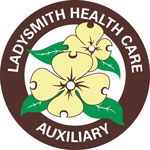LADYSMITH HEALTH CARE AUXILIARY
1909
A History and Compendium of Caring in Ladysmith
An excerpt from an article that takes an in depth look at service clubs in Ladysmith, B.C.
By Dr. Quentin Goodbody
We are lucky to live in a community as caring as Ladysmith. Just how caring is reflected in a long history of philanthropic organizations in the town. To understand the origin of these organizations we must understand the social context at the time they were formed.
Before the development of large-scale government and employer health insurance and other financial services in Canada which form the backbone of our Social Security system (prompted in part by the Great Depression in the 1930's) ‘Friendly Societies’ played an important role in many people's lives as membership provided support in times of unemployment, sickness and bereavement.
An early form of Friendly Societies in Europe were tradesmen’s Guilds set up in the Middle Ages (1100-1500's). Membership was restricted to persons qualified in and practicing the particular activity relating to the guild – i.e., stonemasons involved in building the great cathedrals and castles, or coopers making barrels.
Expansion of Friendly and/or Benevolent societies occurred in the 17- 1800's when the Industrial Revolution prompted large scale migration from rural areas to dense urban factory settings where poor housing, disease and hunger were contributing to significant social misery. Some of these societies were religion-based, while others were purely secular: some were exclusive with regard to membership while others were more open in their membership policies. In contrast to the very practical reasons for their existence, many had/have elaborate rites and costumes as a form of ‘branding’, celebrating their unique identity and providing a sense of belonging to the membership. Such societies formed the basis for a considerable number of Ladysmith's philanthropic organizations.
On Vancouver Island in the late 1890's, when the focus of coal mining changed from Wellington to the Extension area and the settlement to be incorporated in 1904 as the City of Ladysmith came into existence, there were few state social safety nets in lace. Workplace safety in the coal mines – the predominant employer in the town - was poor. Unions were weak and relatively unable to protect the workers. Accidents were common and at times disastrous. Early residents sought a measure of security and community through belonging to societies, many of which are still active in our community today: others have died out locally, but are still active elsewhere....Directly related to the coal mining history of our region is The Ladysmith Health Care Auxiliary. In 1909 a group of ladies, possibly called ‘The Miners’ Ladies Auxiliary’ gathered to donate their services – possibly to provide succor in the aftermath of the Extension Mine Disaster of October 5th of that year in which 32 men died. After construction of the Ladysmith General Hospital in 1911/12 (which was financed by and administered under the Miners Accident and Burial Fund) this group became “The Ladysmith Hospital Auxiliary”. Subsequent to the change from a full service hospital facility to a community health care centre, the auxiliary in 2006 changed its name to the current “Ladysmith Health Care Auxiliary” (LHCA).
The LHCA makes significant donations of funding for medical equipment to island hospitals now serving Ladysmith citizens. Numerous other entities providing health care services to our community also benefit from LHCA funding. In 2018 the organization donated more than $250K to support local healthcare facilities and health and wellness programs. The LHCA operates the Thrift Store at the corner of 1st Ave. and French St. and a Gift Shop now located in the Healthcare Centre. Other LHCA activities include Knitters & Crafts, Meals on Wheels, Youth Volunteers, maintenance of The Doris Gallagher Memorial Gardens located behind the Ladysmith Community Health Centre at 4th Avenue & Symonds, provision of High School Bursaries, Patient Comforts and a Senior’s Lifeline service in partnership with Philips Lifeline....Covid-19 has interrupted our every day activities and many are feeling the strain financially, physically and mentally. It is heart warming to know in these times of social distancing that our community, through it’s orders, societies and clubs, has a continuing history of really having ‘got it together’ when it comes to looking after each other.
Source: Dr. Quentin Goodbody - Ladysmith & District Historical Society - April 2020
Posted July 15, 2020
THRIFT STORE BUILDING HISTORY
1943
Thrift Store Beginnings

The original Grouhel garage, corner of 1st. and French, early 40's. This is where Big O tires is now. Far right of picture, is an old home that was, the Ladysmith Funeral Home, for many years. Mr. Clayton ran the busines. Bill Grouhel started working for him and many years later bought it. The original home was torn down later and a new Funeral Home built, later bought by Sand's. This is now the Thrift Store.
Source: Barry Dashwood - Facebook - Around Town - Ladysmith Community Board
Posted July 15, 2020
RUMMAGE SALES AND VANITY FAIRS HISTORY
1972
Rummage Sales and Vanity Fairs

Posted July 15, 2020
Ladysmith Health Care Auxiliary Thrift Store You Tube Video in 2013
Ladysmith Health Care Auxiliary Donation to Variety Telethon Show of Hearts in 2019
2023
Ladysmith Health Care Auxiliary History


